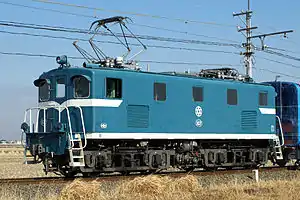Chichibu Railway Class DeKi 100
The Chichibu Railway Class DeKi 100 (秩父鉄道デキ100形) is a Bo-Bo wheel arrangement DC electric locomotive type operated by the private railway operator Chichibu Railway in Saitama Prefecture, Japan, primarily on freight services, since 1951.[1]
| Chichibu Railway Class DeKi 100 | |||||||||||||||||||||
|---|---|---|---|---|---|---|---|---|---|---|---|---|---|---|---|---|---|---|---|---|---|
 DeKi 107 in January 2009 | |||||||||||||||||||||
| |||||||||||||||||||||
| |||||||||||||||||||||
| |||||||||||||||||||||
| |||||||||||||||||||||
As of 1 April 2016, six (DeKi 102-105, 107-108) out of the original eight locomotives are in operation.[2]
Sub-types
The class is divided into three sub-types: locomotive numbers DeKi 101, DeKi 102-106, and DeKi 107-108
- DeKi 101: Built 1951, total power output 640 kW
- DeKi 102-106: Built 1954-56, total power output 800 kW
- DeKi 107-108: Built 1951, purchased from Matsuo Mining Railway, total power output 800 kW
 Preserved DeKi 101 in original brown livery in May 2009
Preserved DeKi 101 in original brown livery in May 2009 DeKi 102 in standard Chichibu Railway blue livery in June 2017
DeKi 102 in standard Chichibu Railway blue livery in June 2017 DeKi 103 in red livery in May 2013
DeKi 103 in red livery in May 2013 DeKi 107 in standard Chichibu Railway blue livery in May 2010
DeKi 107 in standard Chichibu Railway blue livery in May 2010
History
DeKi 101 was built by Hitachi in 1951. The locomotive was privately owned by Chichibu Cement (present-day Taiheiyo Cement), and was initially numbered DeKi 8.[1] It was transferred to Chichibu Railway ownership in 1980.[1]
Locomotives DeKi 102 and 103 were built in 1954 and locomotives DeKi 104 to 106 were built in 1956. These locomotives included uprated traction motors providing a total power output of 800 kW compared to the 640 kW of DeKi 101.[1]
Locomotives DeKi 107 and 108 were purchased in 1973 from the Matsuo Mining Railway (松尾鉱業鉄道) in Iwate Prefecture. Originally numbered ED501 and ED502, these locomotives had similar external dimensions to DeKi 101, but used the same 200 kW traction motors as DeKi 102 to 106.[1] They also feature icicle cutters above the driving cab windows.[1] These two locomotives received the blue with white stripe livery that subsequently became the standard Chichibu Railway locomotive livery, replacing the previous brown livery.[1]
From 1988, DeKi 101 was frequently used as an assisting locomotive at the back of steam-hauled SL Paleo Express services operating on the Chichibu Main Line.[1] This locomotive was withdrawn in 2006, and was repainted into its original brown livery at Hirosegawara Depot, where it remains stored.[1]
Locomotive DeKi 103 was repainted in red livery in 2011, but was returned to the standard blue and white stripe livery in October 2014 following overhaul.[3]
Fleet details
| Number | Manufacturer | Year built | Year withdrawn | Notes |
|---|---|---|---|---|
| DeKi 101 | Hitachi | 1951 | 2006 | Originally Chichibu Cement DeKi 8 |
| DeKi 102 | Hitachi | 1954 | ||
| DeKi 103 | Hitachi | 1954 | Repainted into red livery, 2011-2014 | |
| DeKi 104 | Hitachi | 1956 | ||
| DeKi 105 | Hitachi | 1956 | ||
| DeKi 106 | Hitachi | 1956 | 2008 | Damaged in derailment |
| DeKi 107 | Hitachi | 1951 | Originally Matsuo Mining Railway ED501 | |
| DeKi 108 | Hitachi | 1951 | Originally Matsuo Mining Railway ED502 |
Preserved examples
DeKi 101 is preserved at Hirosegawara Depot.[1]
References
| Wikimedia Commons has media related to Chichibu Railway Deki 100. |
- ELダイヤ情報21 [Electric Loco Timetable Information 21]. Tokyo, Japan: Kotsu Shimbunsha. October 2012. pp. 70–71. ISBN 978-4330320120.
- 私鉄車両編成表 2016 私鉄車両編成表 2016 [Private Railway Rolling Stock Formations - 2016] (in Japanese). Japan: Kotsu Shimbunsha. 25 July 2016. p. 17. ISBN 978-4-330-70116-5.
- 秩父鉄道デキ103が標準色に [Chichibu Railway DeKi 103 returned to standard livery]. Japan Railfan Magazine Online (in Japanese). Japan: Koyusha Co., Ltd. 14 October 2014. Retrieved 31 October 2014.
